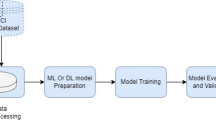Abstract
The automation of interictal epileptiform discharges through deep learning models can increase assertiveness and reduce the time spent on epilepsy diagnosis, making the process faster and more reliable. It was demonstrated that deep sequence networks can be a useful type of algorithm to effectively detect IEDs. Several different deep networks were tested, of which the best three architectures reached average AUC values of 0.96, 0.95 and 0.94, with convergence of test specificity and sensitivity values around 90%, which indicates a good ability to detect IED samples in EEG records.
Access this chapter
Tax calculation will be finalised at checkout
Purchases are for personal use only
Similar content being viewed by others
References
Abdelhameed, A.M., Daoud, H.G., Bayoumi, M.: Deep convolutional bidirectional LSTM recurrent neural network for epileptic seizure detection. In: 2018 16th IEEE International New Circuits and Systems Conference, NEWCAS 2018, pp. 139–143 (2018). https://doi.org/10.1109/NEWCAS.2018.8585542
Beach, R., Reading, R.: The importance of acknowledging clinical uncertainty in the diagnosis of epilepsy and non-epileptic events. Arch. Dis. Childhood 90(12), 1219–1222 (2005). https://doi.org/10.1136/adc.2004.065441
Benbadis, S.: The differential diagnosis of epilepsy: a critical review. Epilepsy Behav. 15(1), 15–21 (2009). https://doi.org/10.1016/j.yebeh.2009.02.024, http://dx.DOI.org/10.1016/j.yebeh.2009.02.024
Bongiorni, L., Balbinot, A.: Evaluation of recurrent neural networks as epileptic seizure predictor. Array 8, 100038 (2020). https://doi.org/10.1016/j.array.2020.100038
Chawla, N.V., Bowyer, K.W., Hall, L.O., Kegelmeyer, W.P.: SMOTE: synthetic minority over-sampling technique. J. Artif. Intell. Res. 16(February 2017), 321–357 (2002). https://doi.org/10.1613/jair.953
Chelgani, S.C., Shahbazi, B., Hadavandi, E.: Learning representations by back-propagating errors. Meas. J. Int. Meas. Confederation 114(2), 102–108 (2018). https://doi.org/10.1016/j.measurement.2017.09.025
da Silva Lourenço, C., Tjepkema-Cloostermans, M.C., van Putten, M.J.: Efficient use of clinical EEG data for deep learning in epilepsy. Clin. Neurophysiol. 132(6), 1234–1240 (2021). https://doi.org/10.1016/j.clinph.2021.01.035
Daoud, H., Bayoumi, M.A.: Efficient Epileptic Seizure Prediction Based on Deep Learning. IEEE Trans. Biomed. Circ. Syst. 13(5), 804–813 (2019). https://doi.org/10.1109/TBCAS.2019.2929053
Dosovitskiy, A., et al.: An Image is Worth 16 \(\times \)16 Words: Transformers for Image Recognition at Scale. CoRR, pp. 1–21 (2020). http://arxiv.org/abs/2010.11929
Fisher, R.S., et al.: Epileptic seizures and epilepsy: definitions proposed by the International League Against Epilepsy (ILAE) and the International Bureau for Epilepsy (IBE). Epilepsia 46(10), 1701–1702 (2005). https://doi.org/10.1111/j.1528-1167.2005.00273_4.x
Goodfellow, I., Bengio, Y., Courville, A.: Deep learning, vol. 29. MIT Press (2016). http://www.deeplearningbook.org
Guler, N.F., Ubeyli, E.D., Guler, I.: Recurrent neural networks employing Lyapunov exponents for EEG signals classification. Expert Syst. Appl. 29(3), 506–514 (2005). https://doi.org/10.1016/j.eswa.2005.04.011
Jiang, K., Liang, S., Meng, L., Zhang, Y., Wang, P., Wang, W.: A two-level attention-based sequence-to-sequence model for accurate inter-patient arrhythmia detection. In: Proceedings - 2020 IEEE International Conference on Bioinformatics and Biomedicine, BIBM 2020, pp. 1029–1033 (2020). https://doi.org/10.1109/BIBM49941.2020.9313453
Johnson, E.L.: Seizures and Epilepsy. Med. Clin. North Am. 103(2), 309–324 (2019). https://doi.org/10.1016/j.mcna.2018.10.002
Lodder, S., Putten, V., Antonius, M.J.: Automated EEG analysis: characterizing the posterior dominant rhythm. J. Neurosci. Meth. 200(1), 86–93 (2011). https://doi.org/10.1016/j.jneumeth.2011.06.008
Lourenço, C., Tjepkema-Cloostermans, M.C., Teixeira, L.F., van Putten, M.J.: Deep learning for interictal epileptiform discharge detection from Scalp EEG recordings. IFMBE Proc. 76, 1984–1997 (2020). https://doi.org/10.1007/978-3-030-31635-8_237
Rosenow, F., Klein, K.M., Hamer, H.M.: Non-invasive EEG evaluation in epilepsy diagnosis. Expert Rev. Neurother. 15(4), 425–444 (2015). https://doi.org/10.1586/14737175.2015.1025382
Song, H., Rajan, D., Thiagarajan, J.J., Spanias, A.: Attend and diagnose: clinical time series analysis using attention models. In: 32nd AAAI Conference on Artificial Intelligence, AAAI 2018, pp. 4091–4098 (2018)
Tjepkema-Cloostermans, M.C., de Carvalho, R.C., van Putten, M.J.: Deep learning for detection of focal epileptiform discharges from scalp EEG recordings. Clin. Neurophysiol. 129(10), 2191–2196 (2018). https://doi.org/10.1016/j.clinph.2018.06.024
Tsiouris, K.M., Pezoulas, V.C., Zervakis, M., Konitsiotis, S., Koutsouris, D.D., Fotiadis, D.I.: A long short-term memory deep learning network for the prediction of epileptic seizures using EEG signals. Comput. Bio. Med. 99, 24–37 (2018). https://doi.org/10.1016/j.compbiomed.2018.05.019
Vaswani, A., et al.: Attention is all you need. Adv. Neural Inf. Process. Syst. 2017-December(Nips), 5999–6009 (2017)
Yan, G., Liang, S., Zhang, Y., Liu, F.: Fusing transformer model with temporal features for ECG heartbeat classification. In: Proceedings - 2019 IEEE International Conference on Bioinformatics and Biomedicine, BIBM 2019, pp. 898–905 (2019). https://doi.org/10.1109/BIBM47256.2019.8983326
Author information
Authors and Affiliations
Corresponding author
Editor information
Editors and Affiliations
Rights and permissions
Copyright information
© 2022 Springer Nature Switzerland AG
About this paper
Cite this paper
Marques, M., Lourenço, C.d.S., Teixeira, L.F. (2022). Detection of Epilepsy in EEGs Using Deep Sequence Models – A Comparative Study. In: Pinho, A.J., Georgieva, P., Teixeira, L.F., Sánchez, J.A. (eds) Pattern Recognition and Image Analysis. IbPRIA 2022. Lecture Notes in Computer Science, vol 13256. Springer, Cham. https://doi.org/10.1007/978-3-031-04881-4_16
Download citation
DOI: https://doi.org/10.1007/978-3-031-04881-4_16
Published:
Publisher Name: Springer, Cham
Print ISBN: 978-3-031-04880-7
Online ISBN: 978-3-031-04881-4
eBook Packages: Computer ScienceComputer Science (R0)





